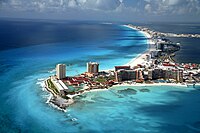
Photo from wikipedia
The linear economic model consumes large amounts of energy and resources, but the limits on its physical capacity are being reached. The circular economy (CE), conversely, is reparative and regenerative;… Click to show full abstract
The linear economic model consumes large amounts of energy and resources, but the limits on its physical capacity are being reached. The circular economy (CE), conversely, is reparative and regenerative; it aims to ensure that products, components, and resources maintain their usefulness and value. Tourism is a generator of wealth and employment worldwide (9.8% of world GDP and 9.1% of world employment), but it also contributes to a variety of environmental problems all over the world. Reducing the negative impacts of the practices of the tourism sector is essential. Therefore, implementing CE practices in this sector is crucial for producing changes that benefit the environment to reach the goal of sustainable development. The objective of this research was to explore the tourism sector knowledge of a CE and the actual implementation of its practices in Puerto Vallarta, and to determine companies´ willingness to design a transition to the CE. Puerto Vallarta, Mexico, is a national tourist destination that ranks among the top three places in the country in terms of the number of tourist visitors, and therefore tourism is the basis of the local economy. A questionnaire was designed to collect information about attitudes and motives, which was answered by key informants from 64 tourism companies. The results show an incipient knowledge about the CE concept. However, companies conducting environmental activities, such as reducing consumption of fossil fuels and improving treatment of waste, indirectly generate a positive impact on the environment. In conclusion, Puerto Vallarta is prepared to implement the CE.
Journal Title: Sustainability
Year Published: 2020
Link to full text (if available)
Share on Social Media: Sign Up to like & get
recommendations!